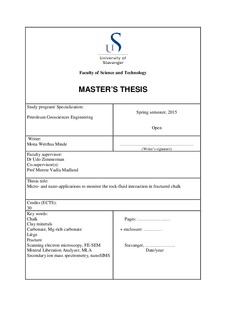| dc.description.abstract | The aim of this project is to contribute to the research of improved oil recovery (IOR) through studying the formation of new mineral phases in a fractured Cretaceous onshore chalk core, flooded with synthetic seawater (SSW). An important aspect is to identify minerals present after flooding and to understand how the composition of the rock influences the fluid-flow inside the core, hence affecting the mechanical properties and compaction of chalk. To achieve this goal, a variety of state – of – the – art methods has been applied, which has contributed with different data sets. Two types of fractures have been produced in the core; a) an artificial fracture perpendicular to fluid-flow and b) an natural fracture parallel to fluid-flow. This study will discuss both of these.
The use of Mineral Liberation Analyzer (MLA) and Nano Secondary Ion Mass Spectrometry (NanoSIMS) shows that the texture of the chalk influences the fluid-flow throughout the core and manipulates fluid flow along the fractures.
Micro and nano-sized silicates and minute grains of Mg-rich carbonates most likely grow on larger micron-sized calcite crystals as well as precipitate in pore-space. The carbonates in the fracture show higher Mg and Si concentrations than those of the surrounding matrix. Remarkable is the observation that shell fragments from macrofossils, which are orientated perpendicular to the fluid flow, influences the rock-fluid interaction. In those areas, the chemo-mechanical reactions are disturbed and lead to a less homogeneous fluid character. This shows that fluid flow and flooding movements are, even in seemingly homogeneous rocks like chalk, strongly dependent on the texture, which reflects in this case the environmental conditions during deposition of the carbonate. This has, in turn, a significant effect on the distribution of mineral alteration, which happen during flooding, beyond doubt at micro-scale. If these effects are possible to upscale is out of the scope of this study, but should be an important research goal for EOR investigation activities. Furthermore, the gain of knowledge of chemical and textural alterations, which occur during flooding with non-equilibrium brines, is important input when designing new experiments, in EOR-simulations, and further understanding of the geo-mechanical behaviour of chalk. | nb_NO |

